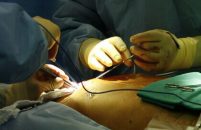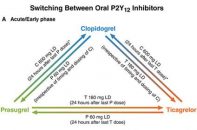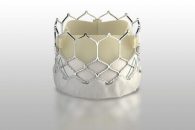Even in the hands of experienced operators, rechanneling and angioplasty of a chronic total occlusion (CTO) results in patients and the whole cath lab team receiving high doses of radiation, according to this registry presented at the American Heart Association 2017 Scientific Sessions. Up to 23% of patients who undergo rechanneling of a CTO receive…
Bilateral Mammary Artery Graft to Reduce the Chance of Repeat Revascularization
According to previous studies, patients receiving bilateral internal mammary artery conduits during coronary artery bypass grafting have better survival than those receiving a single internal mammary artery. The reason behind this remains unclear, let alone whether there really is lower repeat revascularization rate. This analysis compared timing, frequency, and type of repeat coronary revascularization among patients…
Protective Shield RADPAD Reduces the Radiation Dose Received by Operators in the Cath Lab
Despite technological developments, all people working at a cath lab are inevitably exposed to radiation and its effects. The radiation dose received by the operator is highly variable depending on procedure type, experience level, equipment used, patient characteristics, etc. Exposure to this scatter radiation may have deterministic effects, such as the onset of cataracts or…
7 articles on angioplasty that can draw your attention
1) Balloon Angioplasty: A Reasonable Plan B for Chronic Thromboembolic Hypertension Thromboembolic pulmonary hypertension is caused by pulmonary artery stenosis caused by organized thrombi. The only treatment potentially healing for this disease is surgical thrombectomy. However, patients with lesions in very peripheral branches or high surgical risk patients with comorbidities might benefit from a plan B,…
Balloon Angioplasty: A Reasonable Plan B for Chronic Thromboembolic Hypertension
Thromboembolic pulmonary hypertension is caused by pulmonary artery stenosis caused by organized thrombi. The only treatment potentially healing for this disease is surgical thrombectomy. However, patients with lesions in very peripheral branches or high surgical risk patients with comorbidities might benefit from a plan B, such as balloon pulmonary angioplasty. The percentage of patients with chronic…
When and How to Switch Dual Antiplatelet Therapies
Dual antiplatelet therapy with aspirin and a P2Y12 inhibitor is the treatment of choice for patients with acute coronary syndrome who undergo coronary angioplasty. Different oral P2Y12 inhibitors (clopidogrel, prasugrel, ticagrelor) present different characteristics as regards efficacy, risk for bleeding, cost, and timing of administration. In this sense, physicians frequently switch among drugs according to…
New Self-Expanding Valve Measures Up Against Sapien 3
Both balloon-expandable and self-expanding valves have been tested in randomized studies, with excellent outcomes. While both technologies have advantages, the chance to reposition or re-steer the sheath is only offered by self-expanding valves, which also adjust better to patient anatomy. The CHOICE trial, published in 2014 in JAMA, was one of the few randomized studies…
Latest articles about peripheral vascular diseases
1) Efficacy of Micromesh-Covered Stents in Carotid Artery Stenting Most literature, old and recent, associates carotid artery stenting with a higher rate of stroke (although minor) when compared with carotid endarterectomy during the acute period. However, 30-day outcomes of angioplasty and surgery are comparable. Read more 2) Multivessel Disease and Severe Carotid Stenosis: How to Proceed Myocardial revascularization surgery (CABG) is…
DKCRUSH-V: Left Main, Not Just Another Bifurcation
Cardiac Artery Bypass Graft Surgery has been shown more effective than percutaneous coronary intervention (basically because it renders lower revascularization rate) in patients with severe left main bifurcation lesions receiving 1st generation drug eluting stents. This is why the 2014 American guidelines recommend CABG for most patients. But the EXCEL and the NOBLE trials brought back hope to…
Ischemic and Bleeding Risk After Primary Angioplasty
Patients with ST-segment elevation myocardial infarction who undergo primary angioplasty are at high risk for both ischemic and bleeding events, which affect significantly both morbidity and mortality. An optimal selection of antithrombotic therapies in terms of strength and duration must take into account the timing for the procedure, since the risk for these complications may…









